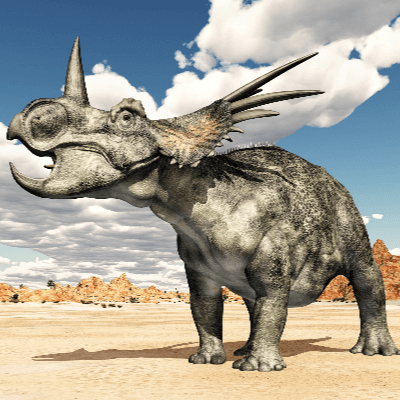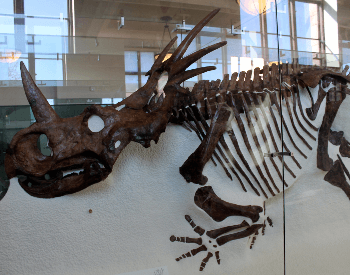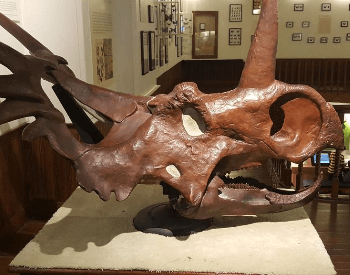
- Species Type: Styracosaurus Albertensis
- Type of Dinosaur: Ceratopsia
- Period: Cretaceous Period
- Diet: Foliage (herbivorous)
- Life Span: Unknown
- Length: 18 feet (average)
- Weight: 3 tons (average)
13 Styracosaurus Facts for Kids
- The Styracosaurus was discovered in 1913 by Charles Mortram Sternberg in the Dinosaur Park Formation in Alberta, Canada.
- The Styracosaurus got its scientific name Styracosaurus albertensis in 1913, by Lawrence Lambe.
- The name Styracosaurus means: “Spiked Lizard”.
- The name Styracosaurus is pronounced: “stih-RAK-uh-SAWR-us”.
- The Styracosaurus was part of a group of dinosaurs known as ceratopsians.
- They lived in the Cretaceous Period (Campanian stage) between 75 and 75.5 million years ago.
- The average length of a Styracosaurus is around 18 feet.
- The average weight of a Styracosaurus is around 3 tons.
- Styracosaurus was a herbivore that ate a wide variety of vegetation near the ground.
- The horn that protruded from the nose of a Styracosaurus could have reached up to 2 feet in length.
- A notable feature of the Styracosaurus is the six parietal spikes that extended from its neck frill.
- Paleontologists think the nose horn and the six parietal spikes on the Styracosaurus’s neck frill might have been used as defensive weapons against predators.
- Paleontologists have found evidence in bonebeds that shows the Styracosaurus might of been a herding dinosaur.
Styracosaurus Pictures

A picture of a Styracosaurus Albertensis SpecimenCredit: Wally Gobetz / Flickr

A sketch of a Styracosaurus Albertensis dinosaur.Credit: Natural History Museum, London

A close-up photo of a Styracosaurus Albertensis skull.Credit: Haxorus54 / Deviant Art
Additional Resources on Styracosaurus
- Styracosaurus – Wikipedia – Learn more about the Styracosaurus on the Wikipedia Website.
- Styracosaurus – Western Australian Museum – Discover more cool facts about the Styracosaurus on the Western Australian Museum website.
- The Last Styracosaurus Standing – In just a few years, three species of Styracosaurus were cut down to just one, learn why.
